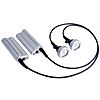 Home : Video course : Module 4: Lighting Underwater Home : Video course : Module 4: Lighting Underwater
What to look for
|
Unless you plan to shoot all your video footage within a couple of
metres of the surface you will need to take your own light source with you
to restore colours and increase contrast. Unfortunately, you cannot use
ordinary dive torches for shooting video because they are not powerful
enough and nearly always have a hot spot in their beam. A purpose built
video light is the solution - but which one? |

|
Batteries
 You need a
lot of power to run a video light and so the efficiency of the batteries is a
major factor in determining any particular unit's efficiency. You need a
lot of power to run a video light and so the efficiency of the batteries is a
major factor in determining any particular unit's efficiency.
It is only
cost effective to use rechargeable batteries in video lights (given the power
demand). These are usually industrial grade Ni-MhNickel Metal Hydride batteries are very efficient and offer about 40% more capacity than NiCD plus they dont suffer from memory effect. However they only last 500 charge and discharge cycles. NiMH batteries lose about 3% of their charge daily. cells (ni-cads) and
you may or may not get a charger included in the cost of the light.
Burn Time

|
Burn time is perhaps the most important
characteristic to look at when choosing a video light. This is simply the
time that you can run it for. Most lights run for no more than 40 mins. In
practical usage however, you do not use your light continuously and may
get a couple of dives out of it. In any event, you are also limited by the
maximum run time on your camcorder battery. |
Lamps
The power of
lamp you need is a matter of personal choice but as a general rule you need more
powerful lights for clearer water (the opposite of what you might expect)
because there is more ambient light for it to compete with.
Chargers
Whatever your
light's burn time it is also important that your batteries will take a
charge quickly so that you do not miss a dive when the inevitable happens - and
you run out of power. It has to be said that fast chargers do curtail the life
of your batteries though.
Fast or slow,
your charger should ideally be dual voltage so that you can run it anywhere in
the world. It's also good advice to buy a spare ni-cad pack to swap over
to in the field.
Size and weight
| Unfortunately, due to high power consumption, you have a weight
penalty for the batteries. The weight, and size becomes important when you
travel a lot and want to keep your excess baggage down to a minimum. If
you could invent a power source of 4.5 AH that weighed only a couple of
ounces then you could make a fortune! |

|
Arms
|

|
Don't forget that you also need an effective arm to mount the light on
the housing. |
Next >> Video Lighting Underwater
|